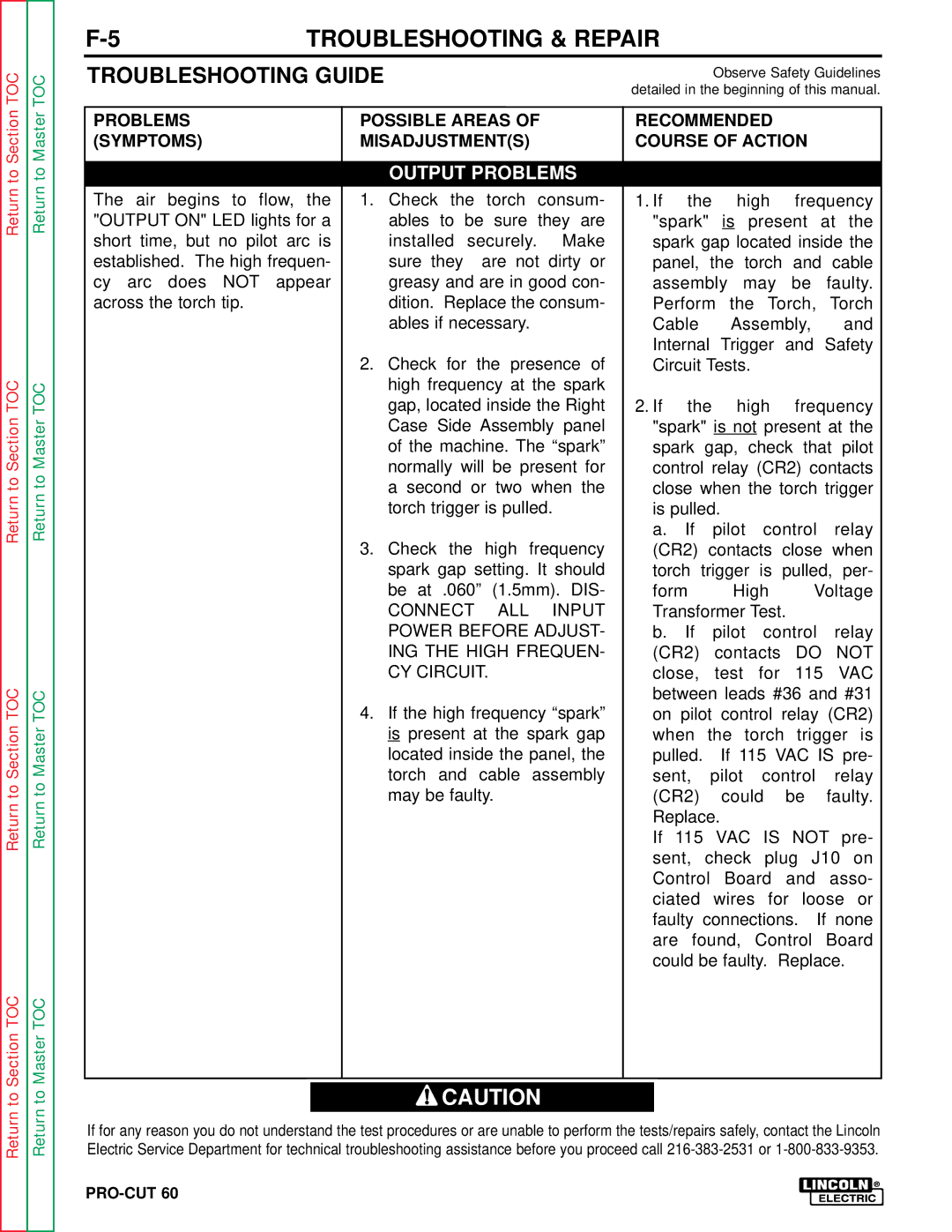
Return to Master TOC
Return to Master TOC
Return to Master TOC
Return to Master TOC
TROUBLESHOOTING & REPAIR |
|
|
|
|
|
|
| |||||
TROUBLESHOOTING GUIDE |
|
|
|
|
| Observe Safety Guidelines | ||||||
|
|
|
|
| detailed in the beginning of this manual. | |||||||
|
|
|
|
|
|
| ||||||
PROBLEMS |
| POSSIBLE AREAS OF |
| RECOMMENDED |
|
| ||||||
(SYMPTOMS) |
| MISADJUSTMENT(S) |
| COURSE OF ACTION |
| |||||||
|
|
|
|
|
|
|
|
|
|
| ||
|
| OUTPUT PROBLEMS |
|
|
|
|
|
|
|
| ||
The air begins to flow, the | 1. Check the torch consum- | 1. If | the |
| high | frequency | ||||||
"OUTPUT ON" LED lights for a | ables to be sure they are | "spark" is present at the | ||||||||||
short time, but no pilot arc is | installed securely. | Make | spark gap located inside the | |||||||||
established. The high frequen- | sure they | are not | dirty or | panel, the torch and cable | ||||||||
cy arc does NOT appear | greasy and are in good con- | assembly | may | be | faulty. | |||||||
across the torch tip. |
| dition. Replace the consum- | Perform | the | Torch, | Torch | ||||||
|
| ables if necessary. |
| Cable |
|
| Assembly, | and | ||||
|
| 2. Check for | the presence of | Internal | Trigger | and | Safety | |||||
|
| Circuit Tests. |
|
|
| |||||||
|
| high frequency at the spark |
|
|
|
|
|
|
|
| ||
|
| gap, located inside the Right | 2. If | the |
| high | frequency | |||||
|
| Case Side Assembly panel | "spark" is not present at the | |||||||||
|
| of the machine. The “spark” | spark gap, check that pilot | |||||||||
|
| normally will be present for | control relay (CR2) contacts | |||||||||
|
| a second or two when the | close when the torch trigger | |||||||||
|
| torch trigger is pulled. | is pulled. |
|
|
|
| |||||
|
| 3. Check the high frequency | a. | If |
| pilot | control | relay | ||||
|
| (CR2) | contacts | close | when | |||||||
|
| spark gap setting. It should | torch trigger is pulled, per- | |||||||||
|
| be at .060” (1.5mm). DIS- | form |
|
| High | Voltage | |||||
|
| CONNECT | ALL | INPUT | Transformer Test. |
| ||||||
|
| POWER BEFORE ADJUST- | b. If pilot control relay | |||||||||
|
| ING THE HIGH FREQUEN- | (CR2) |
| contacts | DO | NOT | |||||
|
| CY CIRCUIT. |
| close, test for 115 VAC | ||||||||
|
| 4. If the high frequency “spark” | between leads #36 and #31 | |||||||||
|
| on pilot control relay (CR2) | ||||||||||
|
| is present at the spark gap | when the torch trigger is | |||||||||
|
| located inside the panel, the | pulled. | If 115 VAC IS pre- | ||||||||
|
| torch and | cable assembly | sent, | pilot | control | relay | |||||
|
| may be faulty. |
| (CR2) |
| could | be | faulty. | ||||
|
|
|
|
| Replace. |
|
|
|
| |||
|
|
|
|
| If 115 VAC IS NOT pre- | |||||||
|
|
|
|
| sent, check plug J10 on | |||||||
|
|
|
|
| Control Board and asso- | |||||||
|
|
|
|
| ciated wires for loose or | |||||||
|
|
|
|
| faulty | connections. If none | ||||||
|
|
|
|
| are | found, | Control | Board | ||||
|
|
|
|
| could be faulty. Replace. | |||||||
|
|
|
|
|
|
|
|
|
|
|
|
|
![]() CAUTION
CAUTION
If for any reason you do not understand the test procedures or are unable to perform the tests/repairs safely, contact the Lincoln Electric Service Department for technical troubleshooting assistance before you proceed call
